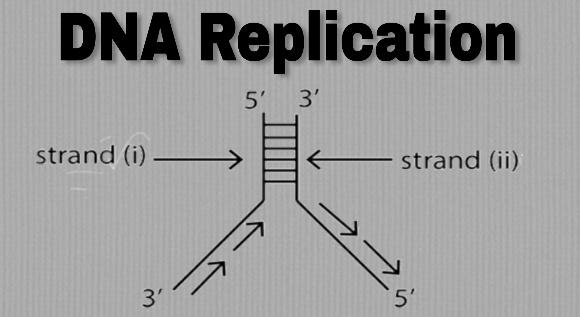
What is incorrect about the above figure representing DNA replication?
A. The direction of DNA replication in strand (i)

B. The direction of DNA replication in strand (ii)
C. Discontinuous replication of strand (i)
D. Discontinuous replication of strand (ii)

Answer
552k+ views
Hint: DNA polymerase can polymerize nucleotides only in 5′→3′ direction on 3′→5′ strand due to the adding them at the 3′ end. Since the two strands of DNA run in antiparallel paths, the two templates furnish different ends for replication.
Complete answer: When a cell divides, it is significant that each daughter cell obtains a comparable copy of the DNA. This is achieved by the procedure of DNA replication. The counterpart of DNA happens during the synthesis phase, or S stage, of the cell cycle, before the cell joins mitosis or meiosis. The elucidation of the configuration of the dual helix furnished a hint as to how DNA is copied. Recollect that adenine nucleotides band with thymine nucleotides, as well as with cytosine with guanine. This implies that the two strands are complementary to each other. Here, in the given diagram strand, (i) indicates the continuous strand or we can say a leading strand, on the other hand, strand (ii) represents the discontinuous or the lagging strand. In the lagging strand, okazaki fragments are formed which are later on attached together to form a new complementary strand of the template DNA with help of DNA ligase.
So, the right answer to the question is Option – C “Discontinuous replication stands (i)”
Note: In the DNA replication over the two templates dividend in contrary directions. One strand with polarity 3′→5′ forms its corresponding strands continuously due to the 3′end of the latter is clear for elongation. It is known as the leading strand.
Complete answer: When a cell divides, it is significant that each daughter cell obtains a comparable copy of the DNA. This is achieved by the procedure of DNA replication. The counterpart of DNA happens during the synthesis phase, or S stage, of the cell cycle, before the cell joins mitosis or meiosis. The elucidation of the configuration of the dual helix furnished a hint as to how DNA is copied. Recollect that adenine nucleotides band with thymine nucleotides, as well as with cytosine with guanine. This implies that the two strands are complementary to each other. Here, in the given diagram strand, (i) indicates the continuous strand or we can say a leading strand, on the other hand, strand (ii) represents the discontinuous or the lagging strand. In the lagging strand, okazaki fragments are formed which are later on attached together to form a new complementary strand of the template DNA with help of DNA ligase.
So, the right answer to the question is Option – C “Discontinuous replication stands (i)”
Note: In the DNA replication over the two templates dividend in contrary directions. One strand with polarity 3′→5′ forms its corresponding strands continuously due to the 3′end of the latter is clear for elongation. It is known as the leading strand.
Recently Updated Pages
Master Class 12 English: Engaging Questions & Answers for Success

Master Class 12 Business Studies: Engaging Questions & Answers for Success

Master Class 12 Economics: Engaging Questions & Answers for Success

Master Class 12 Social Science: Engaging Questions & Answers for Success

Master Class 12 Maths: Engaging Questions & Answers for Success

Master Class 12 Chemistry: Engaging Questions & Answers for Success

Trending doubts
What are the major means of transport Explain each class 12 social science CBSE

Which are the Top 10 Largest Countries of the World?

Draw a labelled sketch of the human eye class 12 physics CBSE

Explain sex determination in humans with line diag class 12 biology CBSE

Explain sex determination in humans with the help of class 12 biology CBSE

Differentiate between homogeneous and heterogeneous class 12 chemistry CBSE




